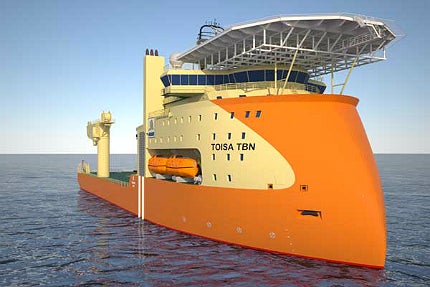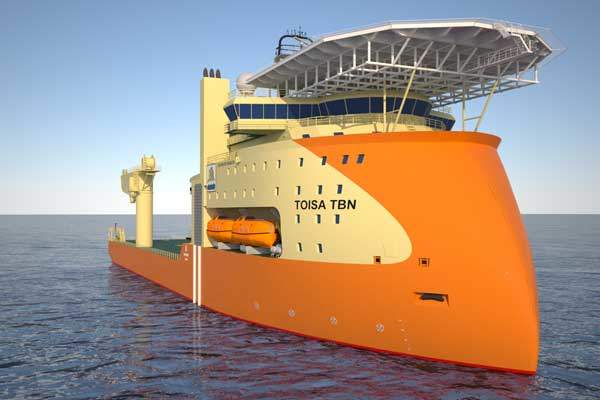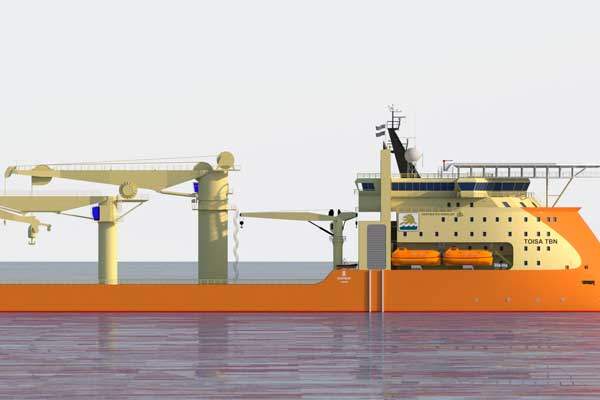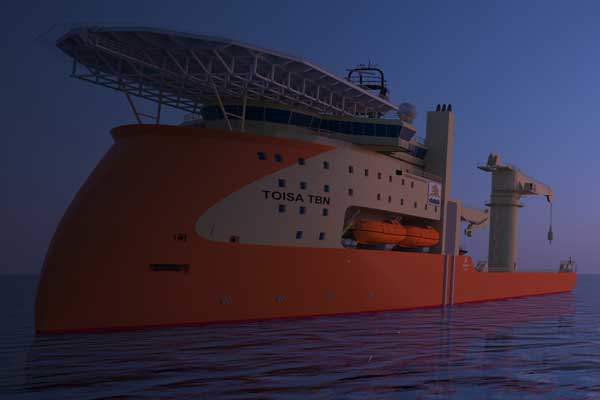
Toisa, a marine services provider, contracted Hyundai Heavy Industries (HHI) in February 2013, to construct a multipurpose offshore construction vessel (MOCV) based on the X-Bow hull design. The offshore vessel will be a tailor-made version of the ULSTEIN’s MOCV, Deepwater Enabler.
The new MOCV will be the first vessel featuring the Ulstein X-Bow hull design to be constructed in Korea and will also be the largest vessel featuring an X-Bow hull.
The vessel is set to be delivered in 2015 and will be operated by UK-based Sealion Shipping.
The vessel is designed to operate and serve oil and gas industries worldwide. It will be capable of carrying out ultra deepwater installation and construction activities, including subsea pipeline and cable laying, and provide topside construction support work for FPSO and drilling rigs.
X-Bow hull design advantages
The X-Bow hull design, which the vessel incorporates, is a backward continuous sloping bow that starts at the extreme front of the vessel, allowing for the sharpest possible bow shape.
The vessel will have a slender hull, offering a significant speed advantage by eliminating spray and enabling a soft entry into the waves.
The design enables the vessel to part the waves efficiently and minimise the transfer of wave energy, compared to vessels with conventional hulls where waves are pushed forward and wave energy is moved against the hull, leading to greater speed losses.
The design enables the vessel to respond to large waves and maintain high speeds, with reduced resistance and reduced fuel consumption.
Details of Toisa’s Multipurpose Offshore Construction Vessel
Toisa’s new MOCV will have a length of 150.4m, beam of 32m and moulded depth of 13.3m.
The deck area of the vessel will be about 2,900m² and the deck strength will be 50t per m³ at key areas.
The area will be specially-built to provide enough space for installation of project equipment, such as pipelay spreads, and for the carriage and deployment of heavy offshore equipment.
Accommodation and facilities on the MOCV
The MOCV will provide accommodation for 250 people. Accommodation facilities aboard the vessel will include spacious cabins, offices, operations rooms and recreational areas.
The ship is designed to meet the DNV Comfort Class COMF-V(3) standard, limiting noise and vibration aboard the vessel.
The vessel will feature an enclosed hangar in which two large work class remotely operated vehicles (ROVs) can either be deployed on port and starboard sides, or through a central moon pool. It will also be integrated with ROV control rooms.
The vessel will be feature a helideck with a maximum take-off weight of 15.6t and a D value of 28.5m.
Crane facilities and optional features onboard
The vessel will be equipped with a fully active heave compensated (AHC) offshore crane with a safe working load (SWL) capacity of 900t with a depth capability of 3,500m. It will also feature an AHC knuckle-boom crane with an SWL capacity of 200t and a depth capability of 2,000m.
The vessel will further be equipped with two deck cranes rated at 20t.
The vessel is designed to provide maximum capability and flexibility. It will have the option of being equipped with a 550t flex lay tower over the main moon pool and two 2,500t capacity carousel spaces below deck. It also has an option of deploying a deck mounted diving bell through a central moonpool.
The vessel will be equipped with the required interfaces to service both ROVs and saturation dive system.
Propulsion and machinery on Toisa’s MOCV
The vessel will be fitted with six diesel-electric generating sets rated at 3,730kW each. The machinery spaces are divided into two engine rooms, each containing three of the main gensets.
The main propulsion will be provided by three stern fixed pitch azimuthing thrusters rated at 3,350kW. The MOCV will further be fitted with two bow tunnel thrusters rated at 2,500kW each and two bow retractable azimuthing thrusters rated at 3,350kW each.
The machinery, power and control systems will be physically separated throughout the vessel, complying with the requirements for IMO Equipment Class 3 dynamic positioning (DP) system.
The vessel will also be integrated with vessel management and control system for all key functions.
The MOCV will be capable of sailing at a speed of 14.3kt.
Related content
Aker Wayfarer Multipurpose Construction Vessel, Norway
Aker Wayfarer is an advanced multipurpose offshore construction vessel capable of undertaking subsea installation, floater installations, topside floatovers and removal operations.
Aura-Class Multipurpose Deck Cargo Vessels, Finland
The Aura-Class multipurpose deck dry cargo vessels are owned by Gaiamare, a subsidiary of Meriaura Oy.










